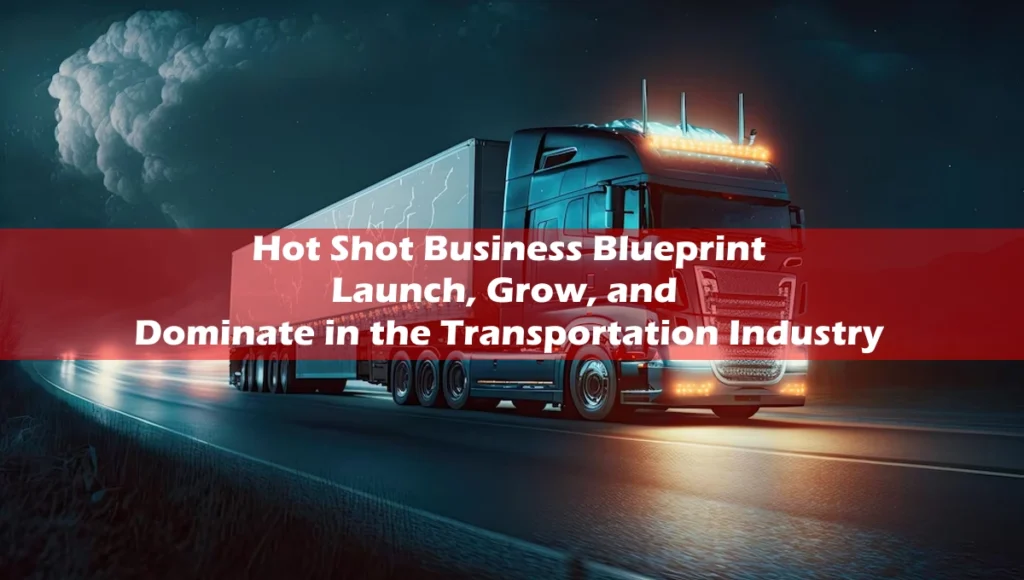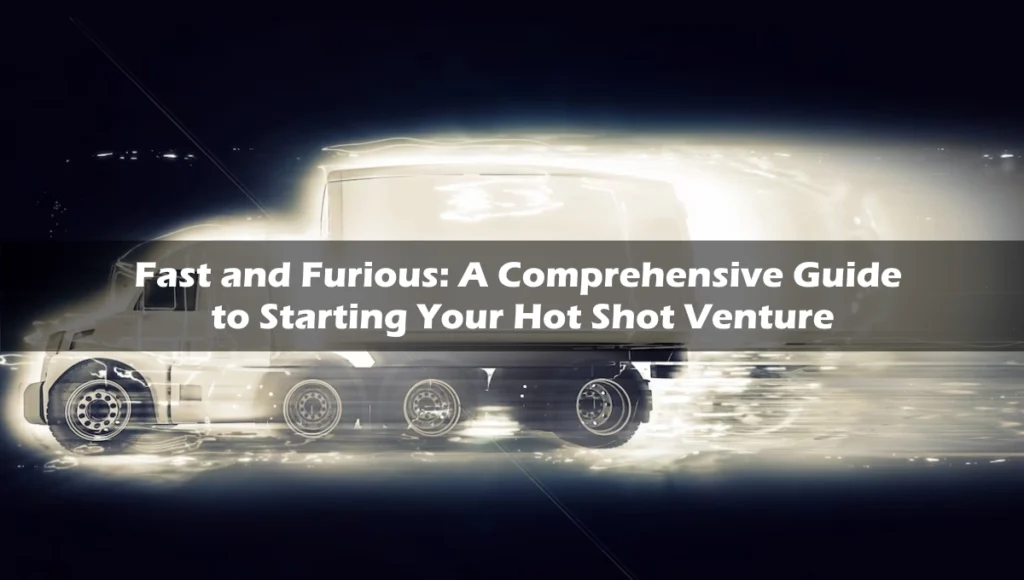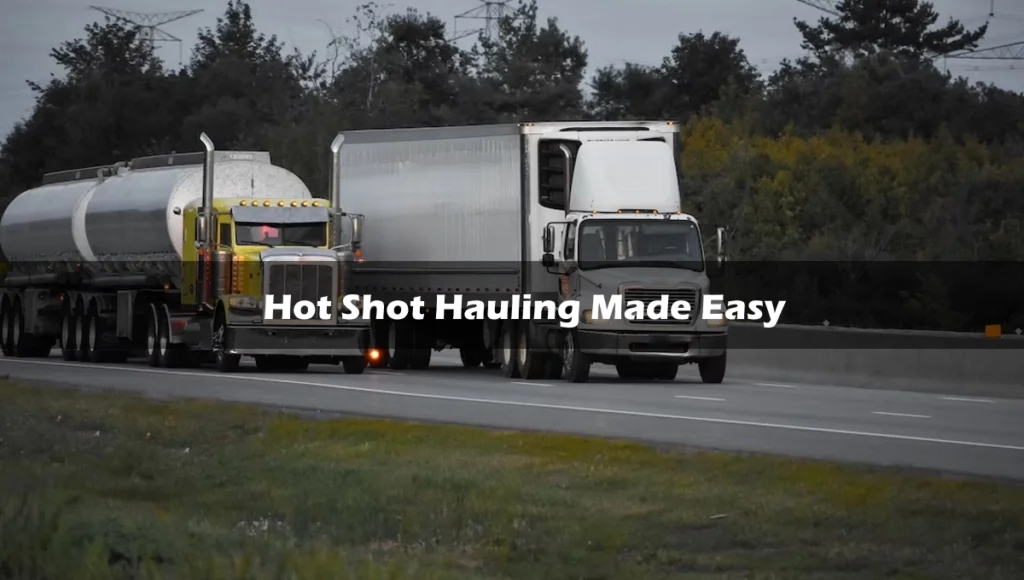How to Start a Hot Shot Business
Are you looking to venture into the transportation industry with a unique and profitable business? Starting a hot shot business might be the perfect opportunity for you. In this article, we will guide you through the essential steps and considerations to help you establish a successful hot shot business from scratch.

Table of Contents
Introduction: What is a Hot Shot business?
A hot shot business involves providing expedited freight services for small and time-sensitive loads. It typically caters to clients who require immediate delivery of goods and materials, often within a specific region. Hot shot businesses operate with smaller trucks and trailers, making them more agile and cost-effective for quick deliveries compared to larger freight carriers.
Understanding the market demand for hot shot services
Before diving into the hot shot business, it’s crucial to assess the market demand in your target area. Research the industries and businesses that frequently require expedited shipping services, such as oil and gas, construction, and manufacturing. Identify the potential clients and their specific needs, which will help you tailor your services and marketing strategies accordingly.
Assessing the necessary resources and requirements
To kickstart your hot shot business, you need to ensure you have the necessary resources and meet the required legal and operational standards.
Determining the appropriate vehicle
Selecting the right truck and trailer is vital for the success of your hot shot business. Consider factors such as payload capacity, fuel efficiency, and versatility. Popular choices include pickup trucks, flatbed trailers, and gooseneck trailers, depending on the types of loads you plan to transport.
Obtaining the necessary licenses and permits
Operating a hot shot business requires obtaining the appropriate licenses and permits. Check with your local and state transportation authorities to ensure you comply with their regulations. Common requirements include a commercial driver’s license (CDL), Motor Carrier (MC) number, and Unified Carrier Registration (UCR).
Setting up insurance coverage
Protecting your business with the right insurance coverage is crucial. Explore insurance options that cover liability, cargo, and physical damage for your vehicles. Insurance policies specifically tailored for hot shot businesses are available and ensure you are adequately protected in case of accidents or damages.
Building a strong business plan
Like any successful venture, a hot shot business needs a well-crafted business plan to guide its operations and growth. Here are the key components to consider:
Identifying target markets and potential clients
Research and identify the industries and businesses that require expedited shipping services within your chosen region. Develop a target client profile to understand their specific needs, preferences, and pain points.
Conducting market research and competitive analysis
Thorough market research and competitor analysis help you identify opportunities and differentiate your hot shot business from others. Understand the pricing structures, service offerings, and marketing strategies of your competitors to create a competitive advantage.
Establishing pricing strategies
Pricing plays a crucial role in attracting clients and ensuring profitability. Consider factors such as distance, urgency, and market rates when setting your prices. Aim for a balance between competitiveness and profitability.

Setting up a professional online presence
In today’s digital age, having a strong online presence is essential for attracting clients and establishing credibility. Follow these steps to create a professional online presence for your hot shot business:
Creating a website and optimizing it for search engines
Develop a user-friendly website that showcases your services, coverage area, and contact information. Optimize your website using search engine optimization (SEO) techniques to improve its visibility in search engine results.
Utilizing social media platforms for marketing
Leverage popular social media platforms like Facebook, LinkedIn, and Instagram to connect with potential clients and build brand awareness. Share industry news, useful tips, and engaging content to attract and engage your target audience.
Implementing effective SEO techniques
Enhance your online visibility by implementing SEO strategies such as keyword research, optimizing meta tags, and creating high-quality content. This will improve your website’s ranking in search engine results, driving organic traffic to your business.
Developing a network of reliable partners and suppliers
To ensure smooth operations and timely deliveries, establish a network of reliable partners and suppliers who can support your hot shot business. Consider the following steps:
Establishing relationships with freight brokers and load boards
Collaborate with reputable freight brokers and utilize load boards to find available loads and maximize your revenue. Building strong relationships with brokers can lead to long-term partnerships and a steady stream of work.
Collaborating with trusted carriers and drivers
Recruit experienced and reliable carriers and drivers who understand the importance of meeting delivery deadlines. Conduct thorough background checks, verify qualifications, and establish clear expectations and communication channels.
Negotiating favorable terms and contracts
When working with partners and suppliers, negotiate contracts and terms that are mutually beneficial. Ensure clarity regarding rates, payment terms, and service expectations to avoid misunderstandings or disputes.
Securing the necessary financing
Launching a hot shot business requires capital investment. Explore the following options to secure the necessary financing:
Exploring funding options for purchasing equipment
Evaluate various funding options, such as loans, leasing programs, or equipment financing, to acquire the required vehicles and equipment. Research local, state, and federal programs that support small businesses in the transportation industry.
Creating a financial projection and budget
Develop a detailed financial projection and budget to understand the revenue streams, expenses, and profitability of your hot shot business. This information will be vital when approaching lenders or investors.
Approaching lenders or investors
Present your business plan and financial projections to potential lenders or investors who specialize in the transportation industry. Provide them with a clear understanding of your business model, competitive advantage, and growth potential.
Acquiring the essential equipment and tools
To operate a hot shot business efficiently, you need to invest in the right equipment and tools. Consider the following essentials:
Selecting the right truck and trailer for hot shot hauling
Choose a truck and trailer combination that suits your business needs and can handle the types of loads you plan to transport. Factors such as payload capacity, durability, and fuel efficiency are important considerations.
Investing in GPS tracking and communication systems
Equip your vehicles with reliable GPS tracking systems to monitor shipments, improve efficiency, and ensure accurate delivery updates to clients. Additionally, invest in reliable communication systems to maintain contact with drivers and clients throughout the transportation process.
Stocking up on necessary tools and safety equipment
Ensure you have essential tools and safety equipment readily available for your drivers. This may include straps, chains, tarps, safety vests, fire extinguishers, and first aid kits. Safety should always be a top priority.
Ensuring compliance with regulations and safety standards
Compliance with regulations and safety standards is crucial for the smooth operation of your hot shot business. Take the following steps:

Understanding DOT regulations and requirements
Familiarize yourself with the Department of Transportation (DOT) regulations and requirements for operating a hot shot business. Stay up to date with any changes or updates to ensure full compliance in areas such as driver qualifications, hours of service, and vehicle maintenance.
Implementing driver qualification and safety protocols
Establish driver qualification protocols to ensure your drivers meet the necessary standards, including valid licenses, medical certifications, and clean driving records. Additionally, implement comprehensive safety protocols and regular training to minimize accidents and maintain a safe work environment.
Conducting regular inspections and maintenance
Schedule regular inspections and maintenance for your vehicles to promptly identify and address any issues. This proactive approach minimizes the risk of breakdowns or accidents during transportation.
Marketing and promoting your hot shot business
Effective marketing and promotion are vital to attract clients and generate leads. Consider the following strategies:
Creating a strong brand identity
Develop a distinctive brand identity that reflects your hot shot business’s values, reliability, and professionalism. Design a logo, select brand colors, and craft a compelling brand story that resonates with your target audience.
Advertising through various channels
Advertise your services through a combination of online and offline channels. This may include online advertising, local directories, industry publications, and participation in trade shows or community events. Consider targeted advertising to reach specific industries or businesses.
Building relationships with potential clients
Actively engage with potential clients by attending networking events, joining industry associations, and participating in online forums. Establishing personal connections can lead to valuable partnerships and referrals.
Managing and optimizing operations
Efficiently managing your operations is crucial to providing excellent service and maximizing profitability. Consider the following aspects:
Efficiently dispatching and scheduling loads
Implement a reliable dispatching system to allocate loads to your drivers efficiently. Optimize routes and schedules to minimize empty miles and maximize driver utilization.
Tracking and monitoring shipments
Utilize technology and systems to track and monitor shipments in real time. This provides visibility to clients and enables proactive communication regarding the delivery status and any potential delays.
Evaluating performance and making improvements
Regularly assess your business’s performance by analyzing key metrics such as on-time delivery rate, customer satisfaction, and revenue per mile. Identify areas for improvement and implement strategies to enhance operational efficiency and customer experience.
Overcoming common challenges and Pitfalls
Running a hot shot business comes with its own set of challenges. Be prepared to navigate common obstacles, such as:
Dealing with unexpected delays or cancellations
Despite careful planning, unforeseen circumstances can cause delays or cancellations. Establish contingency plans and effective communication channels to manage such situations and minimize their impact on your business and client relationships.
Managing driver and equipment issues
Driver availability, turnover, and equipment maintenance are ongoing challenges in the transportation industry. Implement driver retention strategies, conduct regular performance evaluations, and stay proactive in maintaining your vehicles to mitigate these issues.
Adapting to changing market conditions
The transportation industry is dynamic, influenced by factors such as fuel prices, economic conditions, and regulatory changes. Stay informed about market trends and be adaptable in adjusting your business strategies to meet evolving client needs and industry demands.
Expanding and scaling your hot shot business
Once your hot shot business establishes a solid foundation, you may consider expanding and scaling your operations. Explore the following opportunities:
Identifying opportunities for growth and expansion
Analyze market trends, client demands, and competitive landscapes to identify potential areas for growth and expansion. This may involve targeting new geographic regions, diversifying your service offerings, or specializing in specific industries.
Hiring additional drivers or acquiring more vehicles
As your business grows, you may need to hire additional drivers or invest in more vehicles to meet increasing demands. Ensure your hiring process is thorough, and provide ongoing training and support to maintain the quality and reliability of your services.
Diversifying services or targeting new markets
Consider expanding your service offerings or targeting new markets to broaden your client base. For example, you could offer specialized services such as temperature-controlled transportation or partner with industries that have unique delivery requirements.
Tracking industry trends and staying updated
To remain competitive in the hot shot business, it’s essential to stay informed about industry trends, technological advancements, and regulatory changes. Stay updated through the following methods:
Participating in industry associations and events
Join relevant industry associations and attend conferences or events that provide insights into the transportation industry. Networking with industry professionals and staying abreast of the latest developments can give you a competitive edge.
Following industry publications and online forums
Subscribe to industry publications and follow online forums or discussion groups focused on the transportation and logistics sector. These platforms provide valuable information, discussions, and best practices shared by industry experts.
Embracing technological advancements
Stay informed about emerging technologies and advancements in the transportation industry, such as automated dispatch systems, electronic logging devices (ELDs), and route optimization software. Embracing these innovations can streamline your operations and improve efficiency.
Conclusion
Starting a hotshot business can be an exciting and profitable venture in the transportation industry. Following the steps outlined in this article, you can establish a strong foundation for your business, attract clients, and provide reliable and expedited freight services. Remember to stay adaptable, prioritize safety, and continuously seek opportunities for growth and improvement.
FAQs (Frequently Asked Questions)
What is the difference between a hot shot business and a traditional freight carrier?
A hot shot business specializes in expedited shipping for smaller and time-sensitive loads, often using smaller trucks and trailers. Traditional freight carriers typically handle larger loads and operate with semi-trucks and full-sized trailers.
How much capital do I need to start a hot shot business?
The capital required to start a hot shot business can vary depending on factors such as the cost of equipment, insurance, licensing, and marketing. It’s advisable to create a detailed business plan and budget to determine the specific capital needed for your business.
Do I need a commercial driver’s license (CDL) to operate a hot shot business?
In most cases, a CDL is required to operate a hot shot business. However, the specific requirements may vary depending on the weight and classification of the vehicle, as well as local and state regulations. Check with your local transportation authority for the specific CDL requirements in your area.
How do I find clients for my hot shot business?
Finding clients for your hot shot business involves a combination of marketing and networking. Establishing a professional online presence, attending industry events, and building relationships with potential clients and freight brokers can help you find consistent work.
What insurance coverage do I need for my hot shot business?
Insurance coverage for a hot shot business typically includes liability insurance, cargo insurance, and physical damage coverage for your vehicles. It’s essential to consult with an insurance professional specializing in the transportation industry to ensure you have the appropriate coverage for your specific business needs.
Also, you can read more about
Box Truck Business 101: Your Ultimate Guide to Success
Don’t forget to support us by following us on Google News or Returning to the home page TopicsTalk
Join Telegram and WhatsApp for More updates
Follow us on social media
